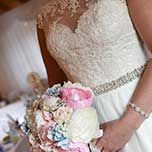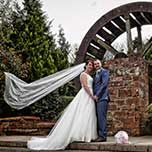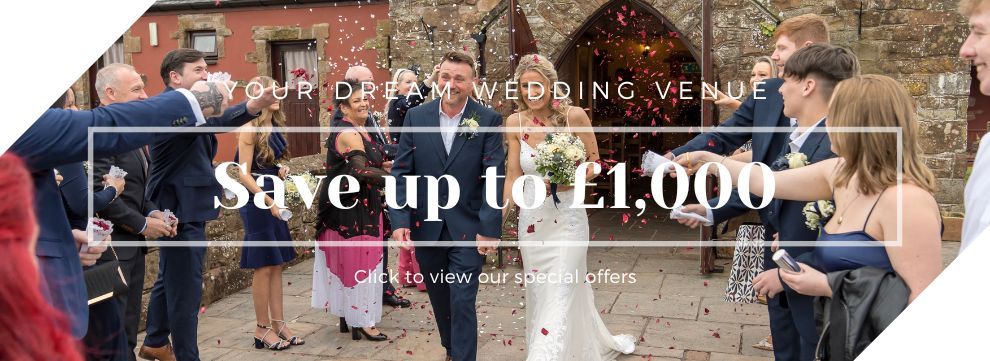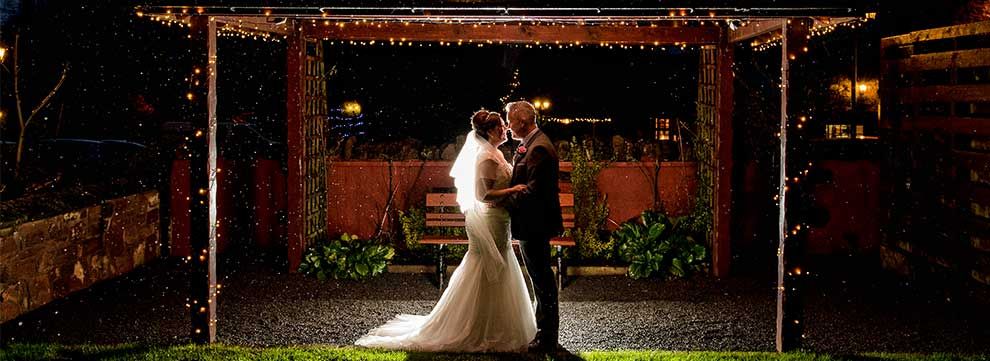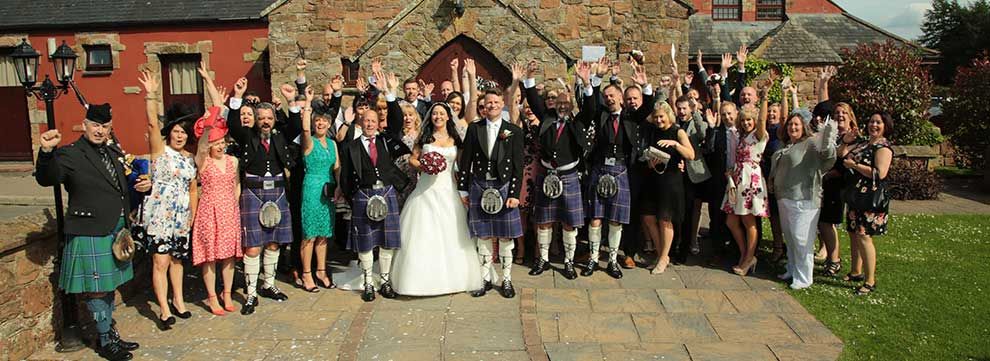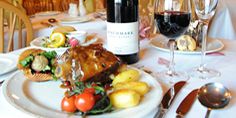Wedding Customs
Weddings are one of the most primeval and least changed rites of passage. Most of the customs observed today are harking back to bygone days.
Everything from the veil, flowers and old shoes to bridesmaids once bore specific and significant meanings. Today we incorporate many of the traditional olde worlde customs into weddings at The Mill Forge.
Wedding Traditions
Definition of "Wedding"
Marriage by purchase was once the preferred custom. The word "wedding" comes from the Anglo-Saxon word wedd which meant that the groom would vow to marry the bride and that the bartered goods and/or currency would go to the bride's father.
The word "wedding" itself comes from the root term meaning to gamble or wager. Thus the ceremony was little more than the purchase of a bride for breeding purposes.
Choosing the Day & Month
Although most weddings now take place on a Saturday it was considered unlucky in the past. A Friday was also considered unlucky (Especially Friday the 13th). The famous rhyme advises a wedding in the first half of the week.
Monday for wealth, Tuesday for health, Wednesday the best day of all, Thursdays for losses, Friday for crosses, Saturday for no luck at all.
The following rhyme advises in which month to be married
Married when the year is new, he will be loving, kind and true.
When February birds do mate, you wed nor dread your fate.
If you wed in March winds blow, joy and sorrow both you will know.
Marry in April when you can, joy for maiden and for man.
Marry in the month of May and you will surely rue the days.
Marry in June roses grow, over land and sea you will go.
Those in July do wed, must labour for their daily bread.
Whoever wed in August be, many a change is sure to see.
Marry in September shrine, your living will be rich and fine.
If in October you do marry, love will come but riches tarry.
If you wed in bleak November, only joys will come remember.
When December snows fall fast, marry and true love will last.
Something Old, Something New
Something Borrowed, Something Blue and a Silver Sixpence in your Shoe is a rhyme from Victorian times yet the customs have much older origins.
Something Old represents the couple's friends who will hopefully remain close during the marriage. This was traditionally a garter given to the bride from a happily married woman in the hope that the happiness would pass to the new bride.
Something New symbolises a happy and prosperous future for the newly-weds.
Something Borrowed is traditionally something lent by the bride's family. The bride must return this much valued family item to ensure good luck.
Something Blue comes from the middle ages when the brides and grooms would wear a blue ribbon as a sign of purity.
The placing of a Silver Sixpence in the shoe is to ensure wealth in married life.
Rings
Wedding rings are an unbroken circle which is to symbolise the everlasting love and are worn on the third finger of the left hand as in roman times it was believed a vein ran from this finger straight to the heart. Engagement rings were first used after Pope Nicholas proclaimed in 860AD that not only was an engagement ring required to seal the agreement of marriage, but that it should be gold to signify financial commitment from the groom. In 1477 King Maximillian presented Mary of Burgundy with a diamond engagement ring and from that day to this diamonds have been a girls best friend.
Bride's Bouquet
After the reception the bride throws her bouquet over her shoulder to a group of unmarried female guests. Tradition states that the person to catch the bouquet will be the next of those present to marry.
A male version of this custom is for the groom to remove the bride's garter and throw it over his shoulder to the unmarried male guests. Once again the catcher will be the first to marry.
Bridesmaids
Bridesmaids were dressed similarly to the bride to act as decoys to confuse evil spirits, thus protecting the bride.
Best Man
In bygone days when the groom would "capture" his bride the best man was there to help him meet any resistance from the girl's family or other suitors.
It is the duty of the best man to protect the groom from bad luck. He must ensure that once the groom has begun his journey to the church he does not return for any reason. He must also ensure that the groom carries a small charm or small mascot in his jacket pocket on his wedding day. The best man should pay the church minister an odd fee to bring good luck to the happy couple.
Confetti
Today we use paper confetti, however confetti is the Italian name for sweets which in Italy are thrown over the couple as they emerge from the church. Before the use of paper confetti the happy couple were showered with petals, grain or rice. This was to bestow prosperity and fertility on the bride and groom.
Shoes
There have been many customs involving shoes which are thought to bring good luck. The best known is for the bride's shoes to be tied to the back of the newlywed's car. This has evolved from the Tudor custom of guests throwing shoes at the happy couple. Apparently it was lucky to be hit by the shoes. Less well known is for the father of the bride to present the groom with a pair of the bride's shoes which symbolises the passing over of responsibility for the bride.
Wedding Breakfast
Traditionally the wedding ceremony took place very early in the morning, therefore the following meal was the breakfast.
Wedding Cake
The wedding cake originated as a fertility symbol in ancient Rome where cakes baked from wheat or barley were broken over the head of the bride for good luck.
Cutting the wedding cake is now part of the whole ritual reception celebration with bride and groom making the first cut together to symbolise their shared future.
Honeymoon
The term honeymoon is thought to originate from the times when a man would capture his bride. The couple would hide from the parents of the bride before marrying and would remain in hiding for a further cycle of the moon after the wedding. During this period they would drink honey wine.
Wedding Favours
Wedding favours traditionally symbolise health, happiness and fertility. Amorous qualities have been attributed to gingerbread down the centuries; Medieval knights presented shield shaped pieces of gingerbread to their ladies during jousting contests and tournaments. Eager maidens even went to the extent of decorating gingerbread with real gold in the hope it would attract the knight of their fancy.
Carrying the Bride Across the Threshold
In the days of marriage by "capture" the bride would not go peacefully into the groom's house and therefore she was dragged or carried over the threshold. Earlier myths are that it prevented demons entering the house on her first visit.
The Couple's First Purchase
It is said that the first partner to buy a new item would be the dominant one in the relationship. many bride's would arrange to make the first purchase by agreeing to buy a small item such as a pin from a chief bridesmaid straight after the ceremony.
Surnames
It used to be thought unlucky for a couple to marry if their surnames began with the same letter which gives the saying - To change the name but not the letter is to to change for worse not for better.
On the Way to the Wedding
As the bride leaves home to go to the wedding it was thought that a last look in the mirror will bring her good luck. However returning to the mirror after she has begun her journey will cause bad luck.
Seeing a chimney sweep on the way to the ceremony will bring good luck as will lambs, toads, spiders, black cats and rainbows.
Arch of Swords
Walking under an arch of swords ensures a safe passage in married life.
Bells
The ringing of bells after a ceremony was intended to frighten away evil spirits which may destroy the happiness of the married couple.
Giving the Bride Away
Fathers giving away their daughters comes from the days of arranged marriages. A father's right was to give his child to the groom, usually for a price. Today a father gives his daughter away as a symbol of his blessing of the union.
Bride on the Left
Grooms in early Anglo-Saxon England would often have to defend their brides during the ceremony, so the bride would stand to his left leaving his sword arm free. This carries on to today with the bride's family on the left and the groom's on the right.
Horseshoes
The horseshoe has long been regarded as a symbol of good luck. In Roman times it was believed that the "U" shape protected against evil. A horseshoe should never be turned upside down lest the good luck fall out. The luckiest horseshoe is said to come form the near hind foot of a grey mare.
The Kiss
The tradition of ending a wedding ceremony with a kiss originates in roman times when a kiss was a legal bond which sealed contracts and thus the betrothal of man and woman. Christianity introduced the betrothal ceremony into the marriage ritual. By occurring at the end of the ceremony the kiss also announces a new life status.
Leap Year Proposals
The right of a woman to propose on the 29th of February originated centuries ago when the leap year day was not recognised by English law. As the day had no legal status then traditions were also believed to have no status, consequently women who feared spinsterhood could take this opportunity to ask the man of their choice.
Purse
Also known as the "Dorothy Bag", "Dilly Bag" or "Dolly Bag" the wedding purse would originally contain confetti or other fertility symbols and was carried by the bridesmaids. In modern times the purse is used as an accessory for the bride's personal effects.
Veil
The bridal veil was originally associated with youth and virginity, enabling the bride to remain modest.
Wedding Dress
The white wedding dress was made popular by Anne of Brittany in 1499. Prior to that time and until the 1900's, a woman would simply wear the best dress in her wardrobe. The wearing of white has been a symbol of celebration since Roman times. In 19th century Victorian times white was considered a sign of affluence as it was assumed that a woman would only be able to wear white once (twice at the most) before the dress became soiled. At the beginning of the 20th century white again became a symbol of purity though today it is more regarded to represent celebration and joy.
Learn more about wedding anniversaries, wedding quotes and wedding etiquette on our wedding trivia page.

